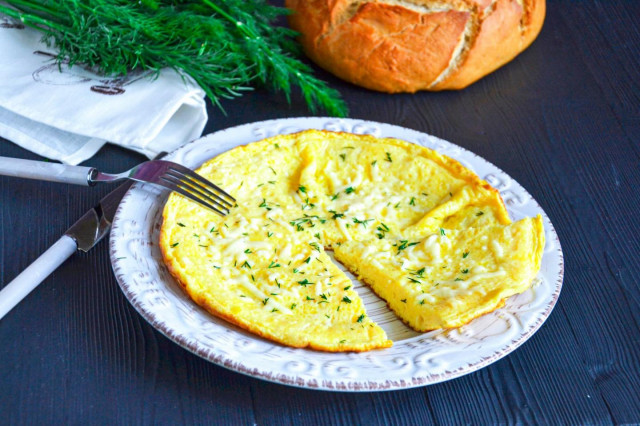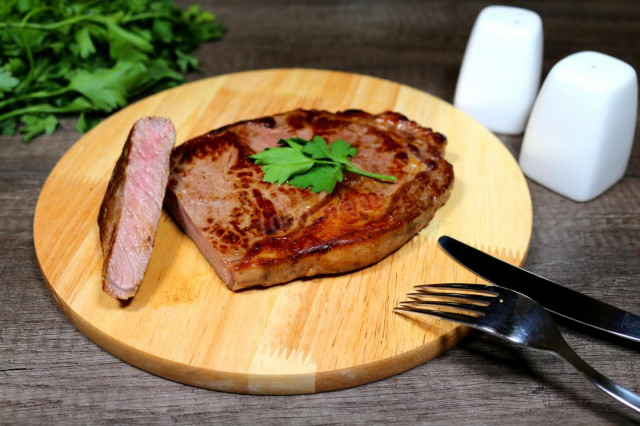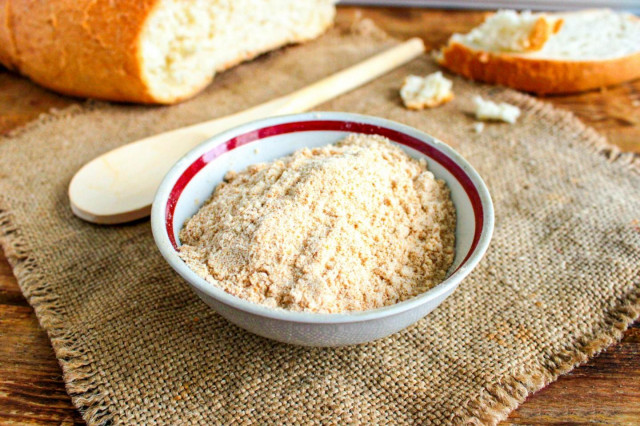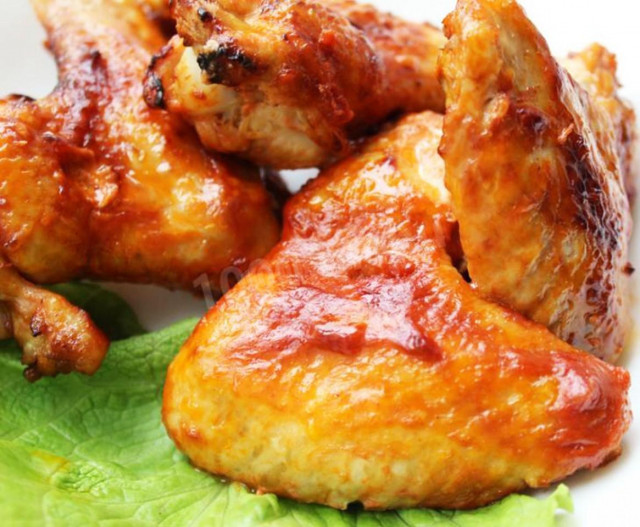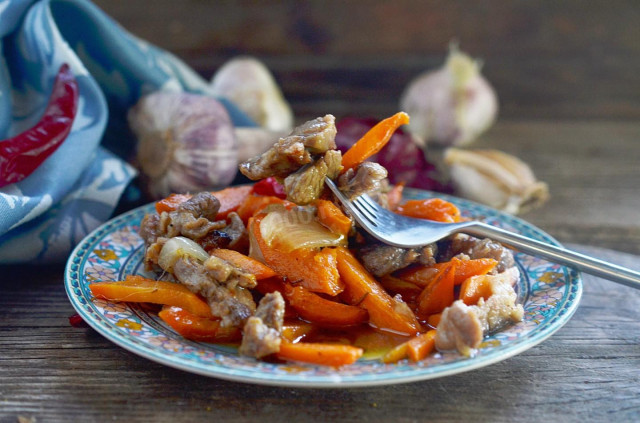Composition / ingredients
Step-by-step cooking
Step 1:
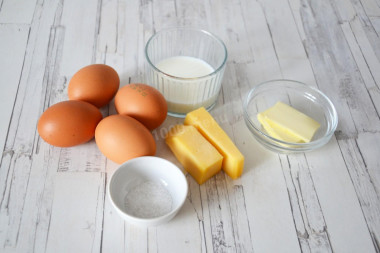
How to make a fluffy omelet with milk and cheese in a frying pan? Prepare the ingredients. Eggs should be fresh, the most delicious omelet will be made from rustic eggs. Any cheese will do, as long as it is of high quality and without milk fat substitutes.
Step 2:
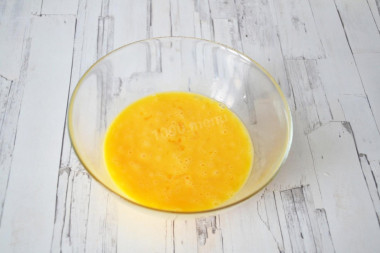
Take a deep bowl, break the eggs into it and stir with a whisk until smooth. You do not need to beat hard, just combine the protein with the yolk.
Step 3:
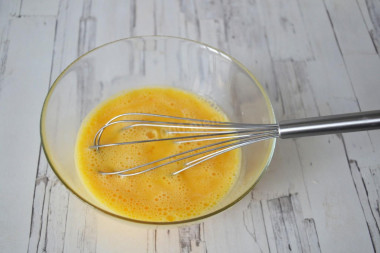
Pour in the milk, add salt. Add salt carefully, considering that the cheese is also salty. Stir the mass again and leave it to stand so that all the salt crystals dissolve.
Step 4:
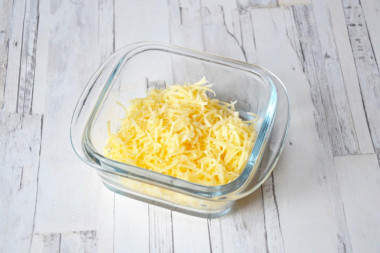
Grate the cheese on a coarse grater. Set aside some of the cheese for serving.
Step 5:
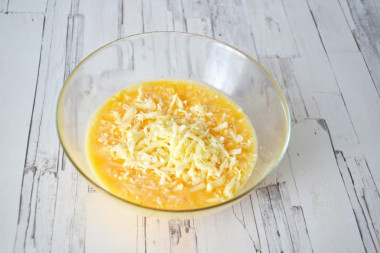
Add the cheese to the beaten eggs and mix.
Step 6:
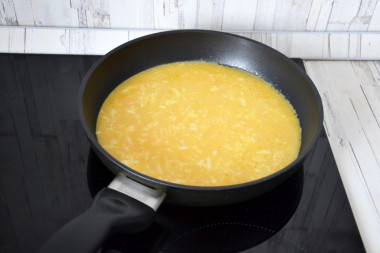
For any omelet, the most important thing is a good thick frying pan with a lid. Then it turns out lush and does not burn from the bottom. I have such a frying pan with a non-stick coating and a thick bottom. Melt a piece of butter in a frying pan over low heat. You can also use vegetable for frying, but with a creamy omelet it turns out much tastier. Pour the egg-cheese mixture into the pan.
Step 7:
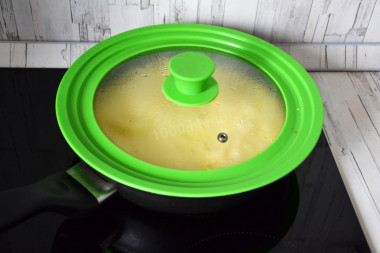
Fry the omelet on low heat under the lid for about 7 minutes. During this time, the omelet will increase well in volume. There should be no wet areas on the surface that have not seized.
Step 8:
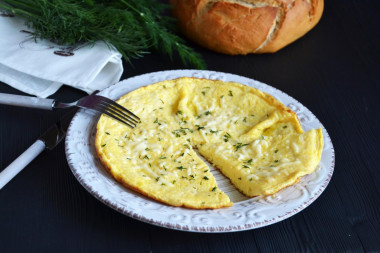
Put the finished omelet on plates, cut into portions. Sprinkle the remaining cheese on top. Bon appetit!
The word omelet is French. In this country, it is believed that every real cook simply must be able to make an omelet. In France, this dish is prepared without water and flour, as in some cuisines of the world, and when serving, it is necessarily rolled up with a tube. Eggs, milk and a frying pan are all you need to make a classic omelet.
Today omelet is used as a side dish, main course, hot and cold appetizer or even dessert. The recipe is modified and improved by adding and changing ingredients. That's why there are more than a dozen varieties of omelet in the world. The appetites of some omelet lovers are stopped only by an allergy to eggs and milk, which are certainly included in the classic recipe. But the simplicity of cooking, on the contrary, attracts even those who have never stood at the stove.
How do I know if an egg is fresh? Break it into a separate container. First of all, there should be no unpleasant smell. The protein of fresh eggs will be transparent and clean. The yolk should not spread and will be shiny, convex, homogeneous.
Be sure to wash the eggs before use, as even the seemingly clean shell may contain harmful bacteria. It is best to use food detergents and a brush.
Since the degree of salinity, sweetness, bitterness, sharpness, acid, burning is individual for everyone, always add spices, spices and seasonings, focusing on your taste! If you put some of the seasonings for the first time, then keep in mind that there are spices that it is especially important not to shift (for example, chili pepper).
Caloric content of the products possible in the composition of the dish
- Whole cow's milk - 68 kcal/100g
- Milk 3.5% fat content - 64 kcal/100g
- Milk 3.2% fat content - 60 kcal/100g
- Milk 1.5% fat content - 47 kcal/100g
- Concentrated milk 7.5% fat content - 140 kcal/100g
- Milk 2.5% fat content - 54 kcal/100g
- Chicken egg - 157 kcal/100g
- Egg white - 45 kcal/100g
- Egg powder - 542 kcal/100g
- Egg yolk - 352 kcal/100g
- Ostrich egg - 118 kcal/100g
- Dutch cheese - 352 kcal/100g
- Swiss cheese - 335 kcal/100g
- Russian cheese - 366 kcal/100g
- Kostroma cheese - 345 kcal/100g
- Yaroslavsky cheese - 361 kcal/100g
- Altai cheese 50% fat content - 356 kcal/100g
- Soviet cheese - 400 kcal/100g
- Cheese "steppe" - 362 kcal/100g
- Cheese "uglichsky" - 347 kcal/100g
- Poshekhonsky cheese - 350 kcal/100g
- Lambert cheese - 377 kcal/100g
- Appnzeller cheese with 50% fat content - 400 kcal/100g
- Chester cheese with 50% fat content - 363 kcal/100g
- Edamer cheese with 40% fat content - 340 kcal/100g
- Cheese with mushrooms of 50% fat content - 395 kcal/100g
- Emmental cheese with 45% fat content - 420 kcal/100g
- Gouda cheese with 45% fat content - 356 kcal/100g
- Aiadeus cheese - 364 kcal/100g
- Dom blanc cheese (semi-hard) - 360 kcal/100g
- Lo spalmino cheese - 61 kcal/100g
- Cheese "etorki" (sheep, hard) - 401 kcal/100g
- White cheese - 100 kcal/100g
- Fat yellow cheese - 260 kcal/100g
- Altai cheese - 355 kcal/100g
- Kaunas cheese - 355 kcal/100g
- Latvian cheese - 316 kcal/100g
- Limburger cheese - 327 kcal/100g
- Lithuanian cheese - 250 kcal/100g
- Lake cheese - 350 kcal/100g
- Gruyere cheese - 396 kcal/100g
- Butter 82% - 734 kcal/100g
- Amateur unsalted butter - 709 kcal/100g
- Unsalted peasant butter - 661 kcal/100g
- Peasant salted butter - 652 kcal/100g
- Melted butter - 869 kcal/100g
- Salt - 0 kcal/100g

